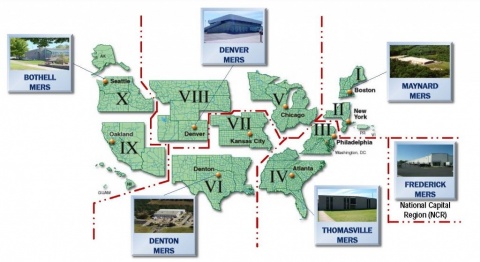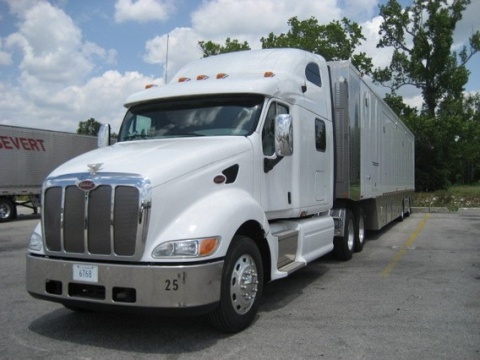Disasters Results
Since 9/11, DHS has made significant progress in how we respond to a wide range of threats, from natural disasters to coordinated attacks.
Establishing and improving a unified incident command system
FEMA has established sixteen Incident Management Assistance Teams (IMATs) that utilize the ICS as their core organizational management structure.
Using the authorities outlined under the Homeland Security Presidential Directive -5 and the Stafford Act, FEMA leads the federal interagency team in support of state governors.
Disaster Emergency Communications

It is important for public safety agencies (such as law enforcement, emergency medical services, and fire services) to be able to provide and maintain communications before, during, and after a disaster or emergency.
Disasters may require resources beyond what local and state authorities can manage. We provide disaster emergency communications through six geographically dispersed Mobile Emergency Response Support detachments and a pre-positioned fleet of Mobile Communications Office Vehicles.
All personnel, systems, and equipment can be driven or airlifted by a military cargo aircraft. The amount of time it takes for an asset to arrive on site depends on the distance to the disaster location and the availability of the airlift.
Mobile Emergency Response Support
Mobile Emergency Response Support provides self-sustaining telecommunications, logistics, and operations support through detachments (staff, equipment, and equipment assets) that are immediately deployable. These detachments can be transported nationally and are able to work together to support a large disaster field office and multiple field operating sites within the disaster area. They are activated at the request of state or tribal emergency management officials.

FEMA Regions
Each detachment has the following capabilities:
Communications
- Provides an office and communications platform capable of moving into a disaster on short notice and can be staffed to meet situational needs.
- Ensures systems interoperability through deployment of:
- Radio equipment (such as Ultra High Frequency, Very High Frequency, and 700 MHz tactical radios)
- Satellite backhaul (to provide voice, data, and video support via satellite)
- Line of Sight / Near Line of Sight microwave systems (for moving data in and out of a disaster area)
- Cross-banding

The Green Hornet: Large-scale emergency operations vehicle
Logistics
- Has generators to supply the power generation requirements of one or more facilities or locations within the disaster area.
- Can provide the heating, ventilation, and cooling requirements for a large office building.
- Can provide diesel fuel.
- Can provide potable water.

Fuel Tanker
Operations
- Support personnel with planning; alert, notification, and deployment monitoring; situational awareness; and reporting.

Incident Response Vehicle
Mobile Communications Office Vehicles
Mobile Communications Office Vehicles are multi-purpose central office facilities that are activated to support FEMA’s response and recovery to/from a disaster. These vehicles are fitted with work stations and satellite communications to provide voice and data connectivity to the FEMA network to support survivors.

Mobile Communications Office Vehicle
During initial deployment, Mobile Communications Office Vehicles are guided by operational coordination, control, and communications requirements received from on-scene emergency management personnel. They’re able to quickly establish a center for survivors to apply for assistance, which is known as a mobile disaster recovery center.
Building Nuclear, Radiological, and Biological Preparedness and Response Measures
State and Local Radiological Emergency Preparedness
DHS’s Domestic Nuclear Detection Office has trained more than 23,000 state and local officers and first responders in radiological and nuclear detection. In addition, through the Securing the Cities initiative, nearly 13,000 personnel in the New York City region have been trained in preventive radiological and nuclear detection operations and nearly 8,500 pieces of radiological detection equipment have been deployed. The Administration has proposed expanding the Securing the Cities initiative to additional high risk regions of the country.
BioWatch
BioWatch is a federally-managed, locally-operated, nationwide bio-surveillance system designed to detect the intentional release of aerosolized biological agents. Through the BioWatch program, an environmental surveillance system that provides early detection of biological agents, DHS’s Office of Health Affairs has collected over 1.1 million samples in more than 30 cities nationwide over the past five years to enhance protection and preparedness for high-consequence biological threats.
Private Sector Preparedness
Voluntary Private Sector Preparedness Accreditation and Certification Program (PS-Prep™)
DHS created the PS-Prep™ program, a partnership between DHS and the private sector that enables private entities to receive emergency preparedness certification. Under PS-Prep™, DHS and FEMA adopted three industry standards to assist organizations in assessing their preparedness and resiliency. In March 2012, DHS certified the first private sector company certified DHS-selected standards under the PS-Prep program.
Ready Business Campaign
FEMA promotes private sector preparedness through its Ready Business campaign, a nationwide initiative that provides materials to businesses to encourage continuity planning and crisis management. Ready Business is part of larger preparedness outreach efforts by FEMA that include the Ready campaign and Citizen Corps, to encourage Americans to prepare for emergencies in their homes, businesses, and communities.
Risk Mitigation Training
Each year, more than 33,000 state, local and private sector partners participate in risk mitigation training on a range of topics including managing floodplain development, planning for post-disaster integrated management, conducting benefit cost analysis and emergency management planning, preparedness, training and education.
Allocating Homeland Security Funding Based on Risk
Since fiscal year 2003, DHS has awarded more than $36 billion in preparedness grant funding based on risk to build and sustain targeted capabilities to prevent, protect against, respond to, and recover from threats or acts of terrorism and natural disasters.
Threat and Hazard Identification and Risk Assessments (THIRAs): Beginning in FY 2012, all states receiving homeland security grant funding are required to develop and maintain a Threat and Hazard Identification and Risk Assessment, which includes the range of threats and hazards faced by an applicant. Through the THIRA process, states will compare existing capabilities with target capabilities to identify potential gaps and focus grant funding accordingly.
 Official website of the Department of Homeland Security
Official website of the Department of Homeland Security
